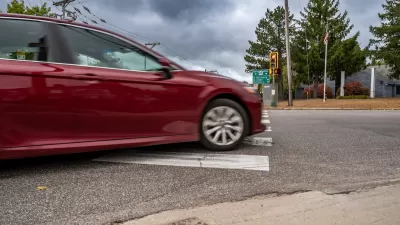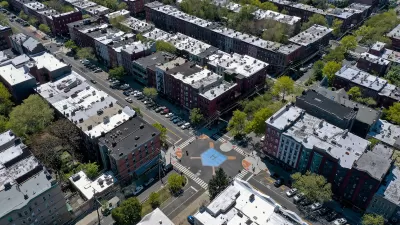After a 19-year hiatus, the city is restarting its traffic calming program to combat the growing pedestrian death crisis.

Almost two decades after Salt Lake City’s last traffic calming projects, a rise in pedestrian deaths has prompted the city to revive its traffic calming program. Jordan Miller details the city’s plan in an article for the Salt Lake Tribune.
A 2019 study assessed the city’s most dangerous roads and potential solutions for improving traffic safety. “The study’s final report identified 403.5 miles of roadway within Salt Lake City for possible improvements and divided those streets into 113 prioritized zones — based on crash data, speed data, demographics and community assets like schools.”
Program components include three versions of speed bumps, raised crosswalks to improve pedestrian visibility, pedestrian refuge islands, and roundabouts. Many of these treatments function best when combined: pedestrian refuge islands and raised crosswalks, for example, provide the most added safety when combined with other speed deflection measures.
See the source article for projected costs and more details on each type of project, the extent of which will depend on future funding.
FULL STORY: In Salt Lake City, here’s what kind of ‘traffic-calming’ projects could be coming to your street

Trump Administration Could Effectively End Housing Voucher Program
Federal officials are eyeing major cuts to the Section 8 program that helps millions of low-income households pay rent.

Planetizen Federal Action Tracker
A weekly monitor of how Trump’s orders and actions are impacting planners and planning in America.

Ken Jennings Launches Transit Web Series
The Jeopardy champ wants you to ride public transit.

Washington Legislature Passes Rent Increase Cap
A bill that caps rent increases at 7 percent plus inflation is headed to the governor’s desk.

From Planning to Action: How LA County Is Rethinking Climate Resilience
Chief Sustainability Officer Rita Kampalath outlines the County’s shift from planning to implementation in its climate resilience efforts, emphasizing cross-departmental coordination, updated recovery strategies, and the need for flexible funding.

New Mexico Aging Department Commits to Helping Seniors Age ‘In Place’ and ‘Autonomously’ in New Draft Plan
As New Mexico’s population of seniors continues to grow, the state’s aging department is proposing expanded initiatives to help seniors maintain their autonomy while also supporting family caregivers.
Urban Design for Planners 1: Software Tools
This six-course series explores essential urban design concepts using open source software and equips planners with the tools they need to participate fully in the urban design process.
Planning for Universal Design
Learn the tools for implementing Universal Design in planning regulations.
Heyer Gruel & Associates PA
Ada County Highway District
Institute for Housing and Urban Development Studies (IHS)
City of Grandview
Harvard GSD Executive Education
Toledo-Lucas County Plan Commissions
Salt Lake City
NYU Wagner Graduate School of Public Service





























